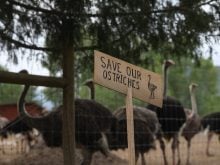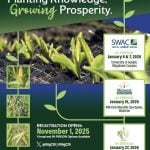CANBERRA, Australia – Australian soil is so dry that when rain falls, none of it runs off into rivers and reservoirs. The land absorbs it all.
Water quality is also diminishing, say government officials monitoring Australia’s worst drought in a century.
“When there is less water, there is more sediment,” said Megan Scott at Australia’s federal agriculture department.
In addition, salinity damage is spreading, particularly in the state of Western Australia. Researchers estimate 14 million acres are at risk from shallow water tables. This could spread to 18.5 million acres.
Read Also

VIDEO: Agritechnica Day 4: Robots and more robots, Nexat loves Canada and the trouble with tariffs
Agritechnica Day 4: Robots and more robots, Nexat loves Canada and the trouble with tariffs.
Australia is entirely dependent on rainwater to replenish reservoirs and rivers.
Since 2001, drought conditions have spread to the point where more than half the agricultural land is designated as being in exceptional circumstances, said Jenny Cupit of the agriculture department.
“A large part of our food bowl is in drought,” she said.
The most severely affected are horticulture crops, vineyards and dairy operations, partly because irrigation is disallowed or curtailed.
The last serious droughts were in the mid-1980s and 1995-96. Many farmers learned about drought management but after many years of dryness, the Murray-Darling river basin that feeds a large portion of Australian agriculture does not carry enough water to sustain farming.
The basin received 282 millimetres of rain in 2006 compared to the historical average of about 500 mm.
Short-term relief arrived when 50 to 100 mm fell across the hardest hit areas in mid-May, but meteorologists say the countryside needs a metre of rain to repair five years of damage.
Rain over the next three months needs to be 10 percent higher than normal to repair damage, especially in Victoria and southeastern Queensland.
With the latest El Nino dying and a La Nina expected, hopes for improvement are iffy, Cupit said.
“There is only a 50 percent chance of rain in this autumn period,” she said.
The lingering drought has damaged farmer confidence, income, crop yields and the environment.
Australia’s largest agriculture lender, Rabobank, conducts quarterly surveys of 2,000 farmers to assess rural confidence.
Released May 28, the survey found slightly more than 30 percent of Australian farmers expected the farm economy to improve in the next 12 months.
More than a third expect conditions to worsen because of drought and a strengthening Australian dollar, which makes their exports worth less on the world market.
However, recent rain should improve farmer attitudes when Rabobank’s next report is released, the survey said.
A few good rainfalls may not be enough to improve farmers’ financial performance. Farm incomes are at the lowest level in more than 30 years, according to government research.
Financial performance was good for 2004-05 when farm prices remained high for grain and livestock.
Farmers could still manage cash flow even with reduced production caused by record high temperatures and little precipitation.
In 2005-06 farm cash receipts fell by nearly 20 percent because of reduced crop receipts.
Wheat prices are expected to hold because of a worldwide increase in demand, but government sources still predict total cash receipts to fall by 40 percent for 2006-07.
With low pasture reserves and high feed prices, southern Australian producers are expected to sell more livestock and reduce herd numbers. That too could drive down prices, when three years before, beef prices buoyed incomes more than any other farm sector.
The burden increased with higher land prices and increasing input costs for fertilizer, machinery, vehicles and farm improvements.
Average farm debt is projected to increase by 15 percent to more than $360,000 Cdn per farm, although equity ratios remain relatively strong.
The proportion of farmers with negative cash income increased from 21 percent in 2005-06 to 42 percent in 2006-07.
Harvests produced good quality but the Australian Bureau of Agricultural and Resource Economics said as of February 2007 production of winter grain such as wheat, canola and lupins fell by more than 60 percent.
Total winter crop production for 2006-07 fell to 15.7 million tonnes, the smallest harvest since 1994-95 when 14.7 million tonnes were produced. New South Wales and Victoria were the hardest hit states.
Politicians cannot make it rain, but state and federal governments are attempting to develop a national water strategy by creating a $1.8 billion government water fund that was announced in January.
The plan includes nationwide investment in irrigation infrastructure, improvements to on-farm irrigation technology and metering and addressing water overallocation problems in the Murray-Darling basin, such as a cap on surface and ground water use, new storage reservoirs and expanding the role of the Bureau of Meteorology to provide better water data for good decision making by governments and industry.















